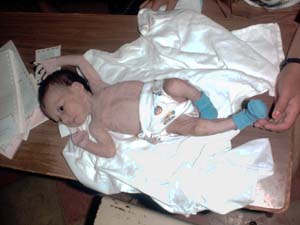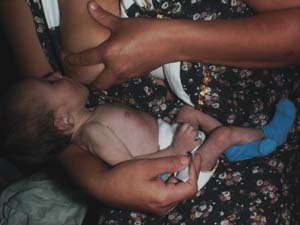Case: 1 month old female with Marasmus


History: 1 mo female who presented with vomiting after every feed and poor weight gain. She was a term baby who was born at home. Mother states that the neonate would not latch on well to her breasts and breastfeeding was stopped at 2 days of life. The neonate was then given a mixture of wheat flour and cow's milk. With each feed, the neonate would have emesis. The emesis was nonbilious and did not contain blood. There was concern for pyloric stenosis and the neonate had an U/S performed.
PE: On physical exam the neonate was alert and easily opened her eyes. She did not appear lethargic. Her skin was dry and appeared loose and wrinkled.
Rad: U/S results were negative for pyloric stenosis.
Assesment: Marasmus
Plan: A woman who was bused in from a nearby village was also being seen that day. She was breastfeeding her child who appeared to have good weight gain. She happened to be a close neighbor to the 1mo female and her family. This neighbor was asked to try and breastfeed the 1mo old there in the clinic. The neonate latched on well and had a good suck. She also did not have any emesis after the feeding. The plan was to have this neighbor breastfeed the neonate during the early months for nutrition and growth.

Discussion: Marasmus is a protein energy malnutrition that predominates in infants. This results from deficient dietary intake sustained over a period of time. The intake of both calories and protein is insufficient, resulting in loss of subcutaneous fat and muscle wasting. These children appear to be emaciated and very cachectic. Their skin is dry and appears loose and wrinkled because of the loss of subcutaneous fat. There is a classic appearance of a sunken face resembling an elderly person. The hair is thin, sparse, and brittle. Adaptive metabolic features include hypothermia, slow heart rate, hypotension and occasionally hypoglycemia when fasting occurs for prolonged periods of time. Other clinical features include irritability, apathy, and stunting of linear growth.
Go to: Tropical Medicine Central Resource | Medical Central Resource